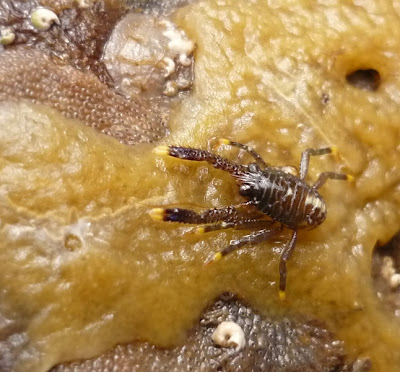This photo shows the anemone with all of its tentacles retracted. It has sticky projections on the outside which attract bits of debris and provide great camouflage.
After reading that they can deal with whole crabs, I wondered how. Forget the web, my scruffy old 1961 reprint of a 1948 edition of 'Animals without Backbones' by Ralph Buchsbaum was more use. Clearly no anemone is going to lift up its skirt and run after a crab so it just sits and waits until one blunders on top of it. Then muscles contract to fold the tentacles inwards and pull the crab inside its insides. Its structure is quite simple - basically just like a purse with a draw string top. Inside the animal there are a series of radial partitions and further sub-folds and along the edges of these are cells that release digestive chemicals. Acidic in nature, they make short work of the calcareous external skeleton of the crab and hey presto - crab soup. One hiccup later and the rubbish gets chucked out from the same orifice as the grub went in. What could be simpler.
c/o Animals without Backbones: Ralph Buchsbaum: Penguin Books 1961
Meanwhile, not far away, I turned over a large stone and found this tiny thing clinging to a layer of sponge. Can a squat lobster be cool? Absolutely. No more than about 5mm long in the body, it was the yellow socks that did it for me. More on squat lobsters next time.








Cracking posting.
ReplyDeleteHave you read that other good book "People without backbones" ?
John
I didn't want to read this as I regret not doing nearly enough rock-pooling this summer :(
ReplyDeleteCaught a squat lobster myself this year: the colour scheme was navy blue and pillar-box red, have no idea what species though.
Nice photos (and writing style, as ever) - most of my aquatic photos ended up with the dreaded flash reflection - arrrgh!
Thanks John. Nice one!
ReplyDeleteHi Theresa and thanks for your kind comments. By the sound of it your squatty was most likely Galathea strigosa, the spiny squat lobster. Just look at this for a fabulous photo :-
ReplyDeletehttp://articles.uwphoto.no/Image_month/previous_Images_of_the_month_9.htm
I agree - rockpool photography is a bother without a camera that you can put under water. We also found a couple of sea hares but I failed miserably to get a decent shot through surface reflections.
Best wishes, Allan